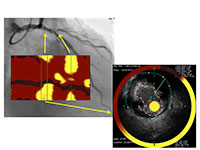Find care now
If you are experiencing a medical emergency, please call 911 or seek care at an emergency room.

Ron Waksman, MD, director of Cardiovascular Research and Advanced Education, is leading an international, multicenter study to determine if the presence of Lipid-Rich Plaques (LRP) can predict a future coronary event.
“We have made good strides in treating cardiac events at the time of the occurrences and understand the characteristics of the vulnerable patient,” Dr. Waksman explains. “Yet events still occur in people we traditionally consider at low or moderate risk.”
“Our hypothesis is that the detection of LRP is an indicator of a vulnerable plaque with dangerous potential. This study will test this hypothesis and create a natural history cohort, which may ultimately include 9,000 enrollees from across several continents,” he says. “Given the current enrollment and event accrual rates, it’s possible the answer to this important vulnerable plaque hypothesis may be answered by the end of this year, or early 2016.”
In this study, patients who present with stable angina or acute coronary syndrome with suspected ischemic heart disease will undergo angiograms to identify any lesions with restricted blood flow. These patients also will undergo imaging with a technology that uses combined intravascular ultrasound (IVUS) with near- infrared spectroscopy (NIRS) catheter [Infraredx; Boston, Mass.] This tool assesses the cholesterol content within the artery walls. The resulting NIRS analysis or chemo- gram will provide important information about arterial lipid composition.
All patients will receive the standard of care treatment with respect to their angiographic and IVUS findings. The chemogram findings will be blinded to the treating physician. The patients with high lipid core burden index (LCBI) or arterial wall lipid composition will be followed closely for two years to determine if a new coronary event has occurred in the areas of high lipid pools.
A randomly selected half of patients with small or low LCBIs will receive identical follow-up care. Patients who experience a new event will undergo imaging to identify the location of the culprit lesions. These imaging results will be compared to the baseline NIRS chemogram.
If chemograms derived from NIRS prove effective in identifying vulnerable plaque in vulnerable patients, “we will have another important surveillance tool, and may ultimately be able to develop effective interventions— drug and/or devices—to minimize the risk for these patients,” Dr. Waksman adds.
For more information, please call Dr. Ron Waksman at (202)-877-5975 or visit MedStarHeartInstitute.org.
Lipid core in the coronary artery as seen via the NIRS infrared imaging technology.















